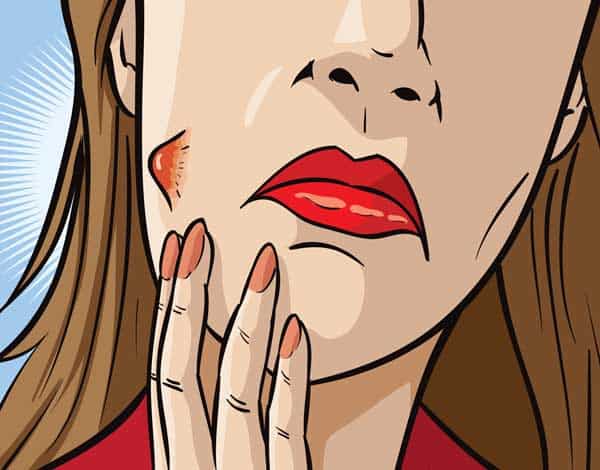Hyperseborrhea is an excessive secretion of sebum, a substance secreted by the sebaceous glands, which protects the skin from microbial aggression and keeps it from drying out.
When physiological functions are normal, the glands secrete just the right amount of sebum for the body. But when these functions go awry, there can be anincreased activity of the sebaceous gland. It then secretes sebum in excess and this is known as hyperseborrhea. It is this hyperseborrhea that is the basis for the development of the various acne lesions.
There are several variants of acne, differing mainly in the degree of evolution.
One can generally make two types of classifications: clinical forms and etiologic forms.
Clinical forms of acne
In this classification, we can distinguish hormonal, retentional, inflammatory, cystic, nodulocystic, conglobata or fulminans acne.
Hormonal acne
Generally speaking, all types of acne are hormonal.
This is due to the phenomenon at the root of acne: it is an inflammation of the pilosebaceous follicle. This follicle is made up of a sebaceous gland with an associated hair.
It is important to remember that not all physiological activities are coordinated by the same physiological center.
Thus, while some are under the control of the nervous system, others are controlled by hormones. The physiological activities directly under nervous control are filled with organs with many nerves.
However, when we examine the sebaceous glands, the importance of nerves is less.
In addition, studies have shown that increased sebaceous gland activity leads to an increase in hormones, especially sexual hormones.
Also, the sebaceous glands are under the influence of androgens (virilizing sex hormones).
These findings therefore allow us to infer that the establishment and development of acne is more likely under hormonal control.
Retentional acne
Retentional acne is the simplest form of acne. Here, there are no complications yet. It is characterized by hyperseborrhea associated with retentional lesions that are called open comedones and microcysts.
The open comedones are small blackheads that can be easily expelled by a simple pressure of the fingers. Then, a yellowish fluid – a mixture of sebum and keratinocytes – comes out and leaves an opening that, again, will soon fill up. Expulsion can also occur spontaneously and it is rare that these comedones are the site of inflammatory phenomena.
The microcysts or “whiteheads” are small white elevations similar to open comedones. Also called closed comedones, they are expressed by the bulging of the skin in the middle of which a pale area forms.
Inflammatory acne
Inflammatory acne is a progressive form of acne due to inflammation of the pilosebaceous follicles. Said inflammation is caused by the bacterial species Propionibacterium acnes – bacteria contained in sebum – which accumulates within the follicles.
This form of acne is characterized by superficial inflammatory lesions: the papules and pustules.
Papules are red elevations between 1 and 5 mm in size. They may appear spontaneously, as they may result from microcysts. When they are treated, their resorption is observed. They can lead to pustules if not treated in time.
Pustules are slightly larger than papules and contain a yellowish purulent fluid. If not treated in time, pustules can also lead to nodules (severe inflammatory lesions).
Cystic Acne
Cystic acne is the one of the most painful forms of acne. It can be very difficult to treat and necessarily requires the advice of a dermatologist. At this point the bacteria infection has evolved.
It is actually an acne characterized by the visible pustular lesions on the surface of the skin and other chronic lesions called cysts. Cysts are encapsulated comedones (lesions that can develop into an abscess) that develop in the deeper layers of the skin.
Cysts are particularly painful and make the disease very difficult to bear for those affected. This deep location means that they are beyond the reach of the usual topically applied treatments, hence the difficulty of treatment.
Cystic acne may leave scars after treatment.
Nodulocystic acne
This is severe acne characterized by inflammatory lesions such as nodules and cysts. In addition, comedones and papules may also be noted.
Here, the lesions are large: the diameter of the nodules can exceed 7 mm. Nodules can give small, painful abscesses that leave permanent scars.
Nodulocystic acne begins like regular acne, but may gradually spread to the neck, chest, back, buttocks, etc.
Acne conglobata
Acne conglobata is an extremely severe form of acne characterized by comedones, papules and pustules. There are also numerous nodules, cysts and even deep abscesses: this is what makes the conglobata form so severe.
Retentional lesions appear and evolve into various chronic lesions leaving cavities (suppurative and fistulized tunnels). These will leave unsightly scars (atrophic and keloids) on the skin.
The lesions of acne conglobata appear mainly on the face, back, shoulders or upper chest. This form of acne is mainly seen in young men.
Acne fulminans
This form of acne is the most severe of all. Fortunately, it is very rare. Generally, its onset is abrupt and occurs in male subjects between the ages of 15 and 30.
It is characterized by numerous inflammatory and suppurative nodules that progress to necrotic ulcerations.
It manifests as hyperthermia – a rise in temperature of up to 40°C – associated with joint pain and a transient sharp increase in white blood cell count (hyperleukocytosis).
Because of the severity of fulminans acne, its management requires hospitalization and specific treatments.
Etiological forms of acne
Regarding the etiological forms, we can distinguish:
Neonatal and infantile acne
It is a transient acne that usually does not require any special treatment. It manifests as pustular lesions, closed comedones and sometimes a few open comedones on the forehead, cheeks or chin.
It is developed by about 20% of newborns, mostly boys. This acne is due to maternal hormonal impregnation.
Iatrogenic acne
This form of acne is due to certain medications perpetuating acne or causing lesions to appear in at-risk subjects.
Thus, some of the drugs causing this acne are steroids (corticosteroids, anabolic agents), iodine or bromine-based drugs, or certain estrogen-progestin contraceptives.
In the case of this acne, iatrogenic eruptions have a more monomorphic appearance – essentially papules and pustules – than perennial acne.
Exogenous acne
It is not uncommon to notice this form of acne among garage workers, milling machine operators, mechanics…: essentially jobs where affected individuals are in contact with highly comedogenic mineral oils.
Indeed, this form of acne develops following exposure to aromatic hydrocarbons.
Thus, it is possible to cite chloracne (or chloric acne). It can be caused in an industrial setting by bisphenols, polyhalogens or naphthalenes, but also by dioxins during accidental contamination.
In the case of chloracne, the onset consists of comedonal lesions that spread to other parts of the body. Cysts and inflammatory lesions may appear later.
Another example would be cosmetic acne caused by concentrated vegetable oils or semi-fluid kerosenes. Although existing, this type of cosmetic acne is quite rare today.
Acne excoriata
This form of acne is diagnosed almost exclusively in women. It sets in following manipulation of minimal acne lesions.
Indeed, many women cannot stand the slightest acne lesion and will lash out at any pimples that appear. Thus, they will rub, scratch, press between their fingers… until an aggravation.
This is a behavior most often reflecting personality disorders: the subjects being well aware that they are aggravating the lesions, but cannot stop themselves from manipulating them.
Acne revealing an endocrinopathy
Generally, endocrine abnormalities are not the basis of acne.
However, acne can sometimes reveal endocrinopathies.
This is sometimes suspected when severe female acne is resistant to treatment or when it is accompanied by signs of hyperandrogenism such as hirsutism, menstrual disorder, hair loss, etc.
In these cases, it is important to perform a hormonal workup of the affected person.
Late acne in women
It is acne present in women after the age of 25. It could either be a case of juvenile acne that has continued into adulthood – or even a relapse of juvenile acne – or it could simply be acne that starts later.
In such cases, a search for a hormonal cause is performed to find, most often, signs of hyperandrogenism.
If these searches are confirmed, a hormonal workup is necessary (as in cases of acne revealing an endocrinopathy).
Rosacea
A pathologic entity quite distinct from acne, rosacea is a facial dermatosis of variable severity typically affecting middle-aged adults – between 40 and 60 years of age.
It is characterized by erythrosis and telangiectasias (rosacea) later associating with pustules.
Easily confused with acne, rosacea is a very distinct dermatosis with different causes and pathophysiologic mechanisms.
To differentiate them, rosacea is characterized by the absence of retentional lesions, since seborrhea is not involved in its establishment.
- Erythrosis is a pattern of redness that may appear on the body and become permanent as the disease progresses.
- Couperose (or telangiectasias) consists of dilated blood vessels visible on the face. These lesions make the skin hypersensitive.
To date, the exact causes of this dermatosis are not known. However, several aggravating factors have been determined. Among these factors, it is possible to cite high and low temperatures, alcohol consumption, physical exercise, sun exposure, stress …
Rosacea occurs in various forms. There are mainly four: the vascular form, the papulo-pustular form, the hypertrophic form and ocular involvement.

